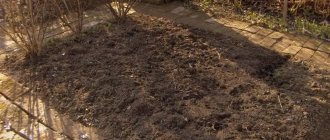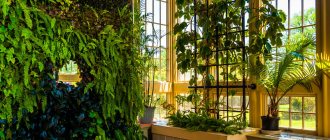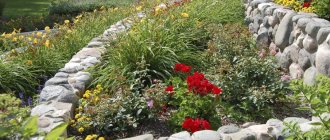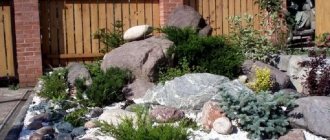“Czech rolling pin”: what kind of animal?
What is a Czech rolling pin? A rock garden in the form of a cracked stone hill, which came to us from the Czech Republic, is formed using rock plates installed edge-on into the ground at a short distance from each other, with the ends of the stone forming a wavy plane. Alpine plant species and dwarf trees are planted in narrow crevices formed between stone plates and covered with substrate and fine gravel on top so that not an iota of the ground is visible. The strangeness of this approach to creating a rocky garden leads to a completely unusual result - it seems that greenery and flowers are breaking through directly from the thickness of the rocks.
The main feature of the “Czech rolling pin” rock garden is maximum naturalness, which is achieved by simulating the principle of the structure of the Czech mountain ranges

To form a Czech rolling pin, stone slabs are installed almost vertically, at an angle of 10-15 degrees relative to the plane perpendicular to the ground

Due to the thin crevices formed between the slabs when forming a Czech rolling pin, it seems that the plants planted in them grow directly from the stone
Why is the Czech rolling pin so good that gardeners from all countries have unanimously switched from building traditional rock gardens to a layered stone slide?
Here are several reasons for this phenomenon:
- Naturalness. The Czech rolling pin almost completely imitates a natural rock formation, introducing a piece of untouched nature in its pristine beauty into the landscape design.
- Balance. Due to the existence of narrow long gaps between the stone slabs, an optimal microclimate is created for the growth of alpine plant species - with moderate humidity and temperature.
- Unpretentiousness. Small distances between the stone plates contribute to the retention of moisture in the soil, because the plane of evaporation is negligible - accordingly, such a hill does not require watering or additional drainage, and there is too little space for the development of weeds in the crevices of the Czech rock garden.

The steep Prahov cliffs and rock outcrops, characteristic of the forest areas of the Czech Republic, inspired Czech gardeners to create the “Czech rolling pin” rock garden.

To create an alpine slide with a Czech rolling pin, you need to select a layered stone and install it almost vertically
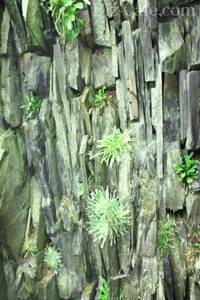
Alpine plants for the Czech rolling pin are planted in the crevices formed when installing stone slabs
Canons of a layered Czech rolling pin:
- The entire Czech hill must be made of one rock in the form of flat slabs of varying thickness, or of more rounded stones, but necessarily having 2 flat edges.
- When creating a Czech rolling pin, slabs of stone must be installed so that narrow and long vertical crevices with a thickness of about 2-5 cm are formed. Thus, the alpine slide will be as close as possible to the natural rock formations characteristic of the Czech mountain ranges.
- Stone slabs for the Czech rolling pin are selected in irregular shapes and buried in the ground in order to create longitudinal and transverse waves, the peaks of which are then emphasized by plants designed to further enhance the dynamics of the miniature mountain range. The Czech rolling pin should have several peaks to create the complete illusion of mountainous terrain.
- The soil cover between the stones formed into a rock garden should be completely invisible, for which all areas of the ground are covered with crushed stone of various fractions.
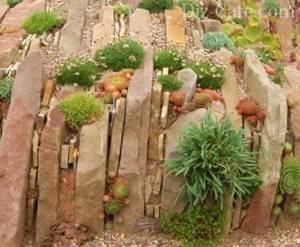
The stone for the rocky garden “Czech rolling pin” is selected in the form of slabs of various thicknesses

When forming a Czech alpine hill, stone slabs are laid both vertically and horizontally
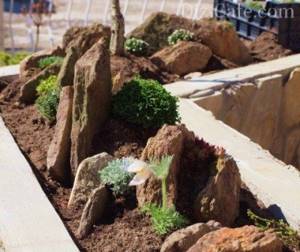
The Czech rolling pin rock garden will be an excellent decoration for a concrete border
We are sure that you are already interested in how to make an alpine slide using the “Czech rolling pin” method, but you don’t know where to start, what types of stone and types of plants to choose for such an original rock garden. We offer you information, as they say, first-hand - it will help you set up a Czech rolling pin in your dacha with minimal effort.
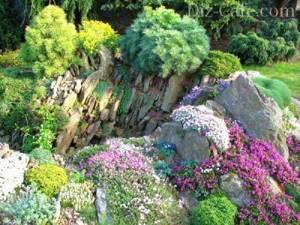
Larger plants are planted on the tops of the Czech rolling pin, emphasizing the dynamics of the height difference

By folding a rock garden “Czech rolling pin”, you can get a fairly strong fence or retaining wall

For horizontal masonry of a Czech rock garden, select stone slabs of different thicknesses
It is important to know! The Czech rolling pin can be formed not only by vertical laying of stone slabs, but also horizontally. In this way you can arrange low borders and retaining walls in the garden.
The main differences between the Czech rolling pin
The indescribable beauty of the mountainous terrain of Czech Moravia inspired designers to transfer a piece of this grace to the garden plots of country houses.
The natural landscape of the Czech Republic is decorated with rocky mountain ledges, abundantly decorated with bright greenery and incredibly beautiful flowers.
Essentially, the Czech rolling pin (layered rolling pin) is an exposed rock formation on which hardy mountain plants are located. Its main difference from other rock gardens is the shape and placement of stones. To create, stones are taken flat and placed vertically (on an edge). This creates the effect of natural rock formation. Stones placed using this technology facilitate easy rooting and intensive growth of plants planted on top of the hill.
The Czech rolling pin adds originality to the garden
Do-it-yourself Czech rolling pin requires less labor than other types of rock gardens. An equally important advantage of this design is the reduction in preparatory work. It does not require preliminary arrangement of a foundation pit, drainage pad, or soil leveling. You can set up a rock garden on a flat ground surface or on natural curves of the landscape. The only disadvantage of such a structure is the absence of a reservoir or stream. So those who want to have a miniature pond on their site should choose a different type of rock garden or try to combine their style.
Choosing a location for the future rock garden
An alpine hill in a country house, or on any other plot of land, is a spectacular accent that gives the garden its originality. However, to achieve a harmonious perception of such a decorative element in landscape design, it is necessary to adhere to some principles for placing a rocky garden. When choosing a location for an alpine slide, two dogmas are followed, which allow solving both botanical and aesthetic problems:
- The very first condition for the successful habitat of a rock garden on your site is the creation of comfortable conditions for plants, in this case we are talking about alpines, whose natural habitat is the mountain Alps. On the one hand, these representatives of the flora are ascetic, hardy and light-loving, but excessive insolation is destructive for them. For this reason, it is best to place a rocky hill on the eastern side of the house - in the morning the sun will illuminate the vegetation, and in the afternoon it will hide behind the house and the rock garden will be in the shade it needs.
- From an aesthetic point of view and for the integrity of the landscape design, it is necessary to provide a favorable foreground and background for the perception of the stone composition. In front of the rock garden, it is best to place a lawn or make a stone fill. The background for the slide should be quite dense - it could be a hedge or frequent planting of coniferous trees and shrubs.

Choose a place for laying the Czech rolling pin rock garden so that in the afternoon the slide is in the shade
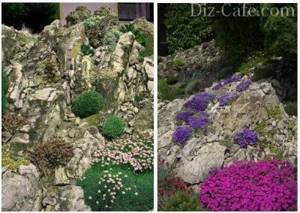
For a harmonious perception of the rocky Czech rolling pin, create a dense background of planting shrubs and trees
Choosing stone and plants for a Czech slide
Based on the fact that the Czech rolling pin has a not quite traditional appearance for a rock garden due to vertically installed stone slabs of different thicknesses, only layered sedimentary rocks - limestone, sandstone, slate - are suitable for it. These types of stone are good because over time, the sharp corners of these relatively soft rocks are smoothed out and the outlines of the slabs acquire a more natural appearance. Among other things, the light ocher or grayish color scheme of the stone of sedimentary origin is pleasant to the eye.
When purchasing stone, it is advisable to immediately estimate how many tons of rock will be used to create your mini mountain range. It is not advisable to purchase additional stone, since slabs from different batches will differ in color, and this is an extremely negative point for the Czech layered slide.
It is important to know! In order to roughly calculate the volume of stone required, we present the consumption of materials when constructing a Czech rolling pin with an area of 20 square meters: limestone - 4 tons, rubble stone (for the base of the peaks) - 1 ton, gravel (for backfilling) - 0.5 tons.

The Czech rolling pin rock garden is formed from layered stone of sedimentary origin - slate, sandstone, limestone

Plants for the alpine slide Czech rolling pin are selected in accordance with its dimensions and to enliven the stone surface - miniature and bright
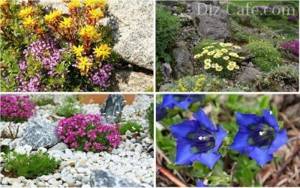
To plant a Czech rolling pin on a rocky hill, it is best to choose miniature, colorfully flowering alpines
Regarding the selection of plants for the Czech rolling pin, there are no special differences compared to a traditional rock garden. As before, the green alpines and dwarf trees should be comparable to the rocker in size and growth rate. Daphnes, bluebells, gerbils, dredges - the list of miniature alpines suitable for landing on a Czech rolling pin can be continued endlessly. The indigenous inhabitants of the Alpine mountains can coexist perfectly with forest and steppe species of flora - ferns, bulbous, dwarf conifers. For planting on the tops of the Czech rolling pin, phlox, krupka, and aubrieta are ideal, and for the slopes - ground cover arabis, tenacious, yaskolka, young, sedum and sedum. Crocuses and muscari will look good at the foot of a rocky alpine hill.
Article on the topic: Selection of plants for an alpine hill: examples of varieties + decor rules
Recent Entries
5 working ways to use tar in the garden 7 indoor plants that help you get married even in adulthood Indoor plants that can bloom in trouble
LiveInternetLiveInternet
Quote from the message Madam_Galya
Read in full In your quotation book or community!

Stones are selected with almost parallel planes. Their size can vary in thickness and length from “slabs” to “plates”. There is no place for rounded stones on a Czech rolling pin, unless at some distance from it. The geodetic nature of all stones for such a slide should preferably be identical. You can use limestone, shale, dolomite, sandstone, etc., i.e. rocks that naturally break down over time in nature. To create a Czech rolling pin, only stones and sand are used; no additional reinforcements are required. A sloping place is preferable, although you can create a “masterpiece” on level ground. The stones are installed only on the edge, if possible at an angle of 5-10 degrees, leaving small gaps. The space between parallel stone slabs is covered with sand, but not completely. Sprinkle thoroughly with water so that the sand is compressed. The settling of sand and the fixation of stones survive for some time. It is worth noting that there were attempts to create Czech rolling pins with horizontal plates, but they did not take root due to their low functionality. When the sand settles, the crevices between the slabs are filled with soil, leaving room for filling with fragments and crumbs of the same type of stone. The main difference between a Czech rolling pin and an alpine slide is that the soil should not be visible in any place. It is necessary to imitate a natural rock outcrop as much as possible.
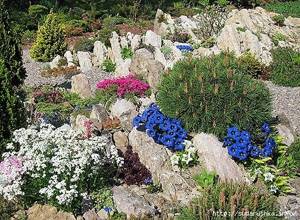
1. The site at the selected location must be cleared, the top layer removed and the site covered with sand.
2. Stones need to be sorted by size and shape.
3. When arranging a Czech rolling pin, a dry laying method is used. That is, only stones and soil. To begin with, several of the largest stones are installed in different places and from them they begin to form a so-called mountain range, installing lower stones in parallel, keeping a distance between them from 1 to 15 cm. Their direction can be arbitrary. In order to indicate the direction of the stone spurs, you can use pegs and a cord. Before filling the soil, the stones can be supported with the help of supports, which can be fragments of stones, bricks, or various wooden spacers. The stones are installed with a slight slope of 5-10 degrees. It is important that the slope is the same for the stones throughout the “rock”.
4. The space between the stones is filled with soil, which can be prepared from a mixture of garden soil, turf soil and fine river sand. The soil is filled in little by little, moistening and compacting.
5. The next step is to start planting plants. Plants should not be buried too deep into the soil, because after planting you will need to make a top layer of gravel.
6. Cover the soil with gravel to completely imitate a mountain landscape. Not a single centimeter of the ground should be visible.
7. We water the structure with a garden hose, thus clearing the stones from the soil and moisturizing the freshly planted plants.
Stages of laying an alpine slide of “Czech design”
Stage 1 – site preparation for construction
Before starting excavation work, decide on the area and outline of the alpine hill - it should be commensurate with the dimensions of your personal plot. As for the excavation work itself, to form a Czech rolling pin it is not necessary to dig a deep pit, as for the construction of traditional alpine slides - it is enough to remove the top layer of soil by 15-20 cm, select the rhizomes of perennial weeds, fill the prepared area under the hill with rubble stone and broken brick . This base is ideal for fixing stone slabs and for drainage - brick fragments will absorb excess moisture, which will protect the plants during the dry period. Although, the very configuration of the Czech fractured hill in the form of rows of deep crevices will facilitate simplified moisture removal.

The direction of laying stone slabs to form a Czech rolling pin is set using a rope tied to the pegs
At the final stage of preparing the site for laying an alpine slide in the garden, the base of rubble stone and brick is covered with a layer of sifted river sand, which will provide additional drainage of the rolling pin and simplify the penetration of the stone into the ground.
Stage 2 – sorting of stone slabs
Before you start installing stone slabs in the ground, it is better to group them into separate piles, according to the size and thickness of the stone. When sorting the material, take a closer look at the appearance of the slabs and select the largest and most expressive specimens for use as the “main” stones of the summits. What should you consider when choosing a stone for the tops of a hill? A relief surface, traces of time in the form of moss and lichen, inclusions of other minerals, colorful stains of color - these are signs of accent stones for a Czech rolling pin, which are installed outward with a spectacular plane. Don’t forget about the ends of the stone blocks - they will become the “face” of the Czech rolling pin, so the slabs should be turned towards the viewer with “tanned” edges, without traces of fresh breaks.
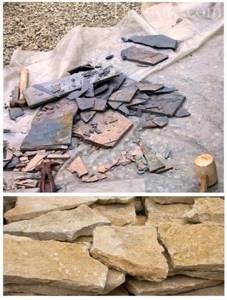
For the convenience of arranging an alpine slide, a Czech rolling pin, it is better to sort the stones by size and thickness
Stage 3 - finding the direction to lay the slide
After the stones for the tops of the rock massif originally from the Czech Republic have been found, they begin to install the slabs in the ground. First, determine the direction for installing the stone plates, which should be positioned strictly parallel to each other, at an angle of 5-10 degrees relative to the vertical. The orientation angle of the crevices between the layers of the rolling pin is selected based on the best view of the rock garden from various vantage points. When the desired direction has been chosen, it is necessary to fix it - drive two pegs into the ground and pull a bright-colored thread so that during the process of laying the rock garden the clear rhythm of the stone plates is not disturbed.

To find the most advantageous direction of stone slabs in a Czech rolling pin, it is advisable to analyze the place for laying the slide from different viewpoints
It is important to know! The optimal width of the crevice formed between the slabs of a Czech rolling pin is 5 cm, the maximum is 20 cm.
Stage 4 – installation of the main vertex
Having decided on the location of the main peak of your rock formation, bury the largest slab at the selected point. To fix the stone in the soil, drive several pieces of rebar or metal rods on both sides of the plate (use a rubber hammer). You can also use foam plastic and brick fragments as additional spacers to maintain the distance between the stone slabs. After the main stone of the rolling pin is buried in the ground and has become stable, you need to carefully compact the top layer of soil with small rakes.
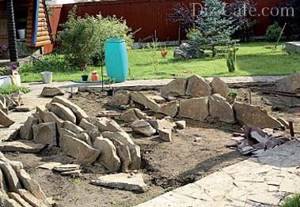
The Czech rolling pin rock garden is laid in a wave-like manner, where the starting point is a peak formed from the largest stone slabs
It is important to know! Please note that the height of the main top of the hill should not exceed 60 cm. If you decide to create a more vertical mountain range, then you need to raise the ground level using an embankment.
Stage 5 – formation of rock waves
From the main peak in both directions, gradually form a wave-like surface of the rock garden using stone plates of different sizes and thicknesses. Try to make the stone waves of the slide asymmetrical, vary them in length, avoid straight lines and regular radii - the Czech rolling pin should be as natural as possible. Several additional peaks, lower than the main peak of the rock ridge, will help enhance the expressiveness of the rock garden. It is recommended to periodically move some distance away from the alpine slide to check the parallelism of the slabs relative to each other, as well as to evaluate the naturalness of the outlines of the side and top planes.
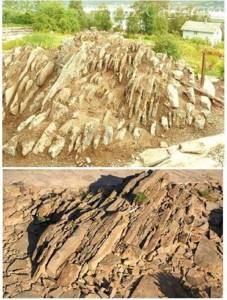
In the process of forming an alpine slide “Czech rolling pin”, stone slabs are installed tightly so that the gaps between them do not exceed 5 cm in thickness
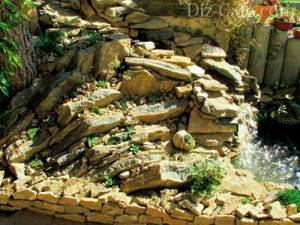
A good addition to the alpine slide, folded in the form of a Czech rolling pin, would be a small waterfall
It is important to know! The Alpine slide “Czech rolling pin” is rarely combined with a waterfall or any other body of water. It copies its natural counterpart - the Czech mountain ranges, which are not characterized by the presence of water near rock formations. However, a layered slide may well be adjacent to a pond if its creator wishes.
Stage 6 – planting plants
The final stage of designing any alpine slide is the formation of planting. The most important point for planting high-mountain representatives of the flora in the open ground of the Czech rolling pin is maintaining the required proportions of the components for the planting mixture. The soil for planting miniature plants from the Alps is prepared as follows: 1/3 - garden or meadow soil, 2/3 - washed river sand with gravel screenings. This composition of the soil for planting alpine plants ensures that it is crumbly and airy; in addition, the soil should not be wet.
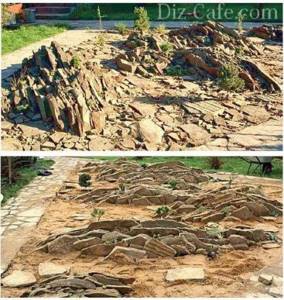
Alpine plants are planted on a Czech rolling pin in narrow cracks formed when installing stone slabs
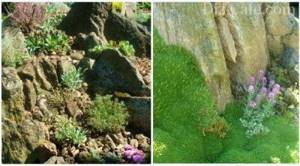
After planting alpine plants on a Czech rolling pin, the planting pocket is filled with substrate and fine gravel

Due to the narrow crevices between the stones formed into a Czech rolling pin, plants are provided with the most favorable conditions for growth
Peaty garden soil will not be entirely suitable for a Czech rolling pin, and for plants sensitive to soil acidity, it is better to immediately add dolomite dust (lime) or peat to the soil mixture; some highlanders need leaf humus.
The simplicity of planting plants on a Czech rolling pin lies in the fact that the crevices between the stone slabs are ready-made deep holes where the plant is placed and filled with the prepared soil mixture up to the root collar. Moreover, there is no need to bury the alpines into the gap itself - the plant should be suspended above the stone in order to then sprinkle the root collar to a thickness of 3-4 cm with crushed stone of various sizes (mulch), creating the illusion of greenery growing directly from the rock. The final touch of planting work when forming a Czech alpine hill is that the planting sites are moistened by drip method to ensure contact of the alpine root system with the soil and clean the stone from earth dust.
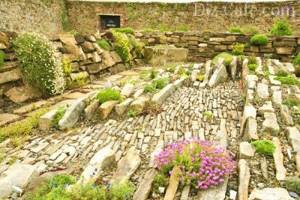
By combining different methods of laying stone, the Czech rolling pin rock garden can be given an original look

Depending on your preferences, you can plant the Czech rolling pin with more plants and give it a picturesque look.
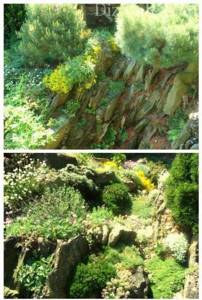
To create a Czech rolling pin with steeper slopes, you need to make an auxiliary mound
Making a Czech rolling pin with your own hands: preparatory work
Preparatory work for creating a layered rolling pin can be divided into several stages:
- Selection of location. The design will look most attractive on a natural slope. If there is no such place on the site, you can make an artificial small embankment that forms the necessary slope. It is also possible to create a work on a flat surface, but this requires a more detailed analysis of its location for harmonious interaction with the rest of the garden landscape.
- Creating a slide project. Transfer your idea to paper. Visualization of the project will make it possible to correctly position the structure and harmonize it with other elements located on the site. Diagram of a Czech rolling pin with different options for laying stones
Viewing photographs of the natural landscapes of the Czech Republic and design projects for a layered rock garden will help you position the slide correctly and make a sketch. After looking at several options, you can create your own project, putting all your wishes on paper. This will significantly speed up the work at the stage of installing stone slabs.
- Selection of material. A DIY Czech rolling pin is made from flat stones of the same type, of different sizes and thicknesses. Limestone, shale, sandstone (flagstone) are good options. Natural delamination will be an advantage in choosing a stone. Round stones and boulders are not used; if desired, they can be placed at a distance from the structure itself, in the form of a threshold in mountainous terrain. You will also need sand, soil for plants, stone chips or crushed stone.

